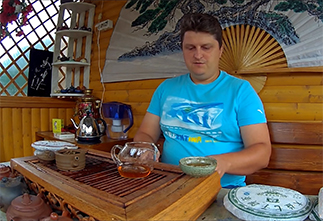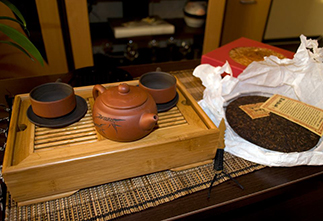Chinese tea Shu Puer 2018 "Bada" brand "Chawanzhai" factory "Jindian"
Shu Pu'er 2018 "Bada" from the brand "Chawanzhai" (茶王寨, chá wáng zhài) of the "Jindian" plant (普洱市金典茶叶有限公司, pǔ'ěr shì jīn diǎn cháyè yǒuxiàn gōngsī, "Jin Dian Tea Company LLC, Pu'er City") is a unique tea that combines rich taste, deep aroma and traditions of one of the most famous tea regions of China. Pressed into a 357 gram Bing Cha (cake) shape, this tea was produced from 2018 raw materials and pressed in 2024, making it especially valuable for pu-erh collectors and connoisseurs.
About the JinDian Plant and the Chawanzhai Brand
The Jin Dian factory was founded in 2007, and its name translates as "Golden Canon" or "Golden Classic", which emphasizes the company's desire to produce tea of the highest quality. The Chawanzhai trademark (or "Tea King Village") also belongs to the factory and symbolizes the continuity of tea art traditions.
Features of the Bada region
Bada is one of the famous tea regions of Yunnan Province, famous for its ancient tea trees and favorable climate conditions. High-mountain plantations, clean air and fertile soils create ideal conditions for the growth of tea trees. Tea from Bada is distinguished by its rich taste, deep aroma and bright energy.
Characteristics of tea
Raw materials and production technology
Bada tea is made from high-quality raw materials collected in 2018. Pressing into the form of Bin Cha was carried out in 2024, which allowed the tea to go through a stage of natural fermentation and acquire a special softness and harmony.
Appearance
The tea cake has a neat shape, typical of traditional Bing Cha. The leaves are evenly pressed, indicating high quality processing. The color of the leaves is dark brown with golden tips.
Aroma
Dry tea has a deep, rich aroma with notes of nut, wood, caramel and a slight earthiness. Once brewed, the aroma opens up, adding hints of dried fruit, chocolate and sweet spice.
Taste
The taste of Bada tea is soft and velvety. The infusion has a rich dark brown color with ruby reflections. The taste is dominated by warm notes of nuts, caramel, dried fruits and light woody bitterness. The aftertaste is long, with pleasant sweetish and spicy shades.
Energy and Impact
Shu Puer "Bada" has a warming effect and promotes relaxation. This tea is ideal for the cold season, as well as for those who appreciate a calm and meditative tea party.
Brewing recommendations
To brew Bada Shu Puerh, it is recommended to use the steeping method in a gaiwan or a Yixing clay teapot. The water temperature should be around 95–100°C. The first steeps should be short (5–10 seconds) to reveal the aroma and avoid excessive bitterness. Gradually, the steeping time can be increased. The tea can withstand up to 8–10 steeps, each of which reveals new facets of taste.
Shu Puer 2018 "Bada" from the brand "Chawanzhai" of the "Jindian" factory is a tea that combines a rich taste, deep aroma and rich energy. Its origin from the Bada region and aging since 2018 make it a real treasure for puer connoisseurs. This tea will give unforgettable moments of pleasure and allow you to feel a connection with the ancient traditions of Chinese tea art.
If you are looking for a tea that can surprise you with its versatility and give you warmth and comfort, Shu Puer "Bada" 2018 is an excellent choice.
|
Name in Chinese
|
普洱市金典茶叶有限公司 |
|
Pinyin
|
pǔ'ěr shì jīn diǎn cháyè yǒuxiàn gōngsī |
|
English name
|
“Bada” brand “Chawangzhai” from the Jindian factory |
|
Translation
|
"Bada" brand "Chawanzhai" |
|
Country
|
China |
|
Provinces
|
Yunnan (云南) |
|
Region
|
Pu'er (普洱) |
|
Habitat
|
Маньчжуань (蛮砖, mánzhuān) |
|
Manufacturer
|
Цзинь дянь (金典, jīn diǎn) |
|
Raw material production date
|
2018 |
|
Year of pressing
|
2024 |
|
Pressing form
|
Bing Cha (Cake Tea) |
|
Declared weight, g
|
357 |
|
Tea tree (bush) variety
|
Da Ye Zhong |
|
Fermentation method
|
In heaps |
|
Size
|
20x20x2 |
|
Length, cm
|
20 |
|
Width, cm
|
20 |
- Комментарии
- Вконтакте
Pu-erh is one of the most unique types of tea, which only gets better with age. Many people, when they first encounter this tea, wondered: why is pu-erh more often found in pressed form (cakes, bricks, tochas), and not in loose form? The reasons for this are related to both history and the practical aspects of storing and fermenting tea. Despite modern technologies that allow the production of loose pu-erh, the shape of pressed cakes remains unchanged. And pu-erh is more often found on sale in pressed form, for example, in the form of cakes or bricks, and loose pu-erh is less common. We will talk about the reasons for pressing pu-erh into cakes in this article.
Puer is a unique Chinese tea that is distinguished by its depth of taste, complexity of aromas and versatility of aftertaste. Its taste characteristics are formed under the influence of many factors, from growing conditions to the brewing method. Let's look at the main ones.
The question often arises: how to brew puerh correctly? Sometimes the phrase "to get high" is added to it. Moreover, everyone has their own understanding of this phrase. Some mean vigor, and some - intoxication. So how to brew puerh tea correctly? Let's consider several options.
Traveling through the tea mountains, we found ourselves in another land of blue roofs - the village of Zhongcai, which is located in the Menghai district of Yunnan province. According to tradition, we were shown another local tea tree, which, according to the Chinese, is at least a million years old :) The village is very authentic, not designed for tourists, there are many wild pu-erhs there and, of course, we were warmly received. They treated us to local cuisine and tea. We also asked the residents about the prices of tea and how they have changed in recent years.
The tea ceremony occupies a special place in the centuries-old Eastern tradition. And although the essence of this phenomenon remains constant, the nature and external manifestations of the tea ceremony in different nations have their own national characteristics. In each Chinese province, the tea ceremony and the tea used in it are varied: for example, residents of the southern provinces prefer green tea, and residents of the northern provinces - red tea, in Fujian province they more often use Oolong tea, and in Yunnan province Puer tea is widely known.

























































































